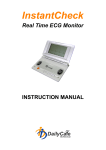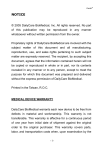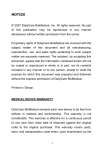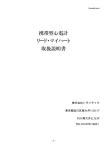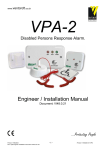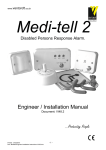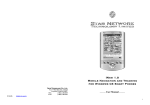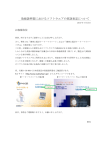Download Manual
Transcript
NOTICE © 2008 DailyCare BioMedical, Inc. All rights reserved. No part of this publication may be reproduced in any manner whatsoever without written permission from the owner. Proprietary rights of DailyCare BioMedical are involved with the subject matter of this document and all manufacturing, reproduction, use, and sales rights pertaining to such subject matter are expressly reserved. The recipient, by accepting this document, agrees that the information contained herein will not be copied or reproduced in whole or in part, nor its contents revealed in any manner or to any person, except to meet the purpose for which this document was prepared and delivered without the express permission of DailyCare BioMedical. Printed in Taiwan, R.O.C. MEDICAL DEVICE WARRANTY DailyCare BioMedical warrants each new device to be free from defects in material and workmanship. This warranty is not transferable. This warranty is effective for a continuous period of one year from initial date of shipment against the original order to the original purchaser. This warranty covers parts, labor, and transportation costs when, upon examination by the manufacturer, the device is determined to be in fact defective. In order to implement the provisions of warranty repair, the I purchaser must notify DailyCare BioMedical concerning suspected defects and then, if so instructed, ship the instrument to the designated facility, correctly packed in an appropriate shipping container, for examination and servicing. LIMITATIONS AND EXCLUSIONS This warranty does not cover repairs necessitated by any damage to equipment caused by mishandling, neglect, abuse, customer modification or failure of the user to follow the published operating instructions. Repaired devices are warranted for a period of 30 days and are subject to the limitations and exclusions described in this document. DailyCare BioMedical reserves the right to make design changes in its products without incurring the obligation to incorporate these changes in products previously delivered. This warranty applies unless DailyCare BioMedical has agreed to and provided a written exception to this policy. II ATTENTION! ReadMyHeart • is NOT a diagnostic device. It is only an ECG recorder. • is NOT a substitute for a traditional ECG diagnosis. • will NOT tell you if you have heart problems. Only your physician can do that. You should NOT interpret the measurement results yourself. • is NOT recommended for users with pacemakers. What you should not do: • Do NOT operate ReadMyHeart at the same time with other electrical devices. • Do NOT connect ReadMyHeart to the PC via USB cable when measuring. • Do NOT use accessories other than those provided by the manufacturer. • Do NOT subject the device to water and liquid spillage. Do NOT clean with alcohol, acetones or any other flammable chemical agents. • Do NOT place the device and its accessories under direct sunlight and harsh environments. • Do NOT disassemble ReadMyHeart. It may cause device malfunction, device failure or damage to the device and you will loose any warranty. III ATTENTION! Please use the device properly by following standard operating procedure. (Please refer to Section 2.2 Page 7) Improper use of the device will cause inaccurate representation of measured results. NOISE indicator may appear if the device is not operated correctly. If your readings are NOT within the reference range, to execute multiple measurements are recommended. As a rule, if you are feeling uncomfortable, regardless of the numbers and symbols on the device, please consult your physician or go to hospital immediately! IV Table of Contents NOTICE ......................................................................................................I MEDICAL DEVICE WARRANTY................................................................I LIMITATIONS AND EXCLUSIONS............................................................II ATTENTION..............................................................................................III INTRODUCTION .......................................................................................1 1.1 BASIC FUNCTION OF THE HEART ............................................................1 1.2 CONDUCTION SYSTEM OF THE HEART ....................................................1 1.3 WHAT IS READMYHEART .......................................................................2 1.4 ECG VARIABLES ..................................................................................3 1.5 BENEFITS OF READMYHEART ................................................................4 1.6 COMMON CAUSES OF ABNORMAL ECG TRACINGS ..................................4 PRODUCT DESCRIPTION........................................................................5 2.1 PRODUCT DESIGN ................................................................................5 2.1.1 Product Package........................................................................5 2.1.2 Product Label .............................................................................5 2.1.3 Exterior Design...........................................................................6 2.2 OPERATING READMYHEART .................................................................7 2.2.1 Procedure...................................................................................7 2.2.2 Control Buttons ..........................................................................9 2.2.3 LCD Display .............................................................................10 2.2.4 LCD Display Description .......................................................... 11 2.3 PRODUCT SPECIFICATIONS .................................................................12 READMYHEART SOFTWARE................................................................13 3.1 SYSTEM REQUIREMENTS ...................................................................13 3.2 INSTALLATION ....................................................................................13 V 3.3 FILE TRANSFER ................................................................................ 14 3.4 SOFTWARE INTERFACE ...................................................................... 17 3.5 USER MANAGEMENT ......................................................................... 18 3.5.1 Add a new User ....................................................................... 19 3.5.2 Delete/Change a User ............................................................. 20 3.5.3 Search for User ....................................................................... 21 3.5.4 Delete, Save, Preview and Print a File .................................... 21 3.5.5 Review ECG Trace and Parameters ....................................... 22 3.5.6 Redefine ECG Parameters...................................................... 23 3.5.7 Reading the Graph .................................................................. 24 3.5.8 ECG Waves and Parameters .................................................. 25 FREQUENTLY ASKED QUESTIONS ..................................................... 27 GLOSSARY ............................................................................................ 32 REFERENCES ........................................................................................ 34 CONTACT INFORMATION ..................................................................... 35 VI INTRODUCTION 1.1 Basic Function of the Heart The heart has 4 chambers that act together to pump blood throughout the body. The 2 smaller upper chambers are called atria, and the larger lower chambers are called ventricles. The right atrium receives oxygen-depleted blood coming back from the body via 2 large veins: the superior vena cava and inferior vena cava. The right atrium pumps this blood into the right ventricle, which then pumps the blood into the lungs, which is oxygenated. The blood then comes back into the left atrium, which is then pumped into the left ventricle. The left ventricle then pumps the blood back to the circulatory system via the aorta, the largest artery in the body. The pressure that the left ventricle exerts to keep the blood moving throughout the whole body is the blood pressure. 1.2 Conduction System of the Heart The chambers of the heart pump with the automatic discharge of electricity from the sinoatrial (SA) node, a group of specialized cells in the right atrium. On average, there are 60 to 100 times discharges per minute. When the SA node discharges, both atria contract, and the electrical impulse is relayed to the atrioventricular (AV) node that is between the 2 ventricles. The electrical wave that is propagated at the AV node causes both ventricles to contract and pump blood. The normal delay between the atrium and ventricle contractions is 0.12 to 0.20 seconds. By studying the electrical activity that results when 1 heart muscle cells contract, we gain insight to the health and workings of the heart. These electrical activities can be detected, recorded and studied with an electrocardiograph (ECG) recorder, for example ReadMyHeart. 1.3 What is ReadMyHeart ReadMyHeart (RMH) is a personalized, non-invasive, handheld ECG monitoring device designed especially for individual and family use. It is not diagnostic in nature, but only for recording. It allows users to measure and record electrical activities of the heart anywhere and any time. The electrical signals from the heart are obtained by placing thumbs on ReadMyHeart’s specially designed conducting electrodes without using any complicated wires or conducting gel. ReadMyHeart takes 25 seconds for each measurement. The device will record 15 seconds of the “Modified ECG signal” 1 and instantly display the average of 3 parameters on the LCD display: the average heart rate (HR), ST segment and QRS interval. These parameters are not the traditional standard ECG readings, but rather a “Modified Lead I-ECG” 2. ReadMyHeart can transfer all recorded measurements to a personal computer through USB connection for easy viewing, managing and printing of ECG recordings. 1 ReadMyHeart uses two conducting electrodes to measure cardiac activities, unlike traditional ECG device which requires at least 3 electrodes. ECG measured by ReadMyHeart is designated as a modified Lead I ECG. 2 These parameters from ReadMyHeart are only for user reference. For interpretation of the parameters, please consult professional physicians. Additional standard 12-lead ECG may need to be performed. 2 1.4 ECG Variables Figure 1. Normal ECG Waveform (Lead I) Figure 1 is a presentation of a normal ECG waveform from Lead I. ReadMyHeart has algorithms that will identify and compute parameters in the table listed below. Table 1 is a list of ECG parameters measured by ReadMyHeart. Table 1 ReadMyHeart Output Parameters Parameters Reference Range Average Heart Rate (HR) 60 < HR <100 bpm* ST Segment (ST) -2 < ST < +2 mm QRS Interval (QRS) 0.08 s < QRS < 0.12 s PR Interval 0.12 ~ 0.20 s QT/QTc 0.32 ~ 0.44 s / 0 .41 ~ 0.44 s 3 1.5 Benefits of ReadMyHeart ReadMyHeart is a recording device used to monitor the electrical activities of the heart anytime anywhere. It is designed to be small, portable and easy to use. With ReadMyHeart you can: • Take measurements anytime anywhere ReadMyHeart is available anytime to periodically monitor the heart throughout the day. • Manage ECG recordings over time ReadMyHeart software allows users to manage their ECG recording to monitor ECG changes over time. • Provide your physicians with these historic data Data generated by ReadMyHeart can be used as a reference when diagnosing for conditions in the future. 1.6 Common Causes of Abnormal ECG Tracings Individuals with high risk factors might have abnormal ECG tracings. These include people who smokes, have high cholesterol, are over weighted or have a family history of cardiovascular diseases. Please consult your physician if you are concerned about your ECG recordings and symptoms. 4 PRODUCT DESCRIPTION 2.1 Product Design 2.1.1 Product Package Standard Package: ; ReadMyHeart device X 1 ; USB Cable X 1 ; ReadMyHeart Software CD X 1 ; ReadMyHeart User’s Manual X 1 ; Auxiliary Electrode Cable X 1 ; EVA Carrying Case X 1 Not Included: 1) 2) Electrode gel pad. These pads can be purchased at local drug stores. AAA alkaline battery. ReadMyHeart needs two to operate. 2.1.2 Product Label CERTIFIED CE MARKING, NOTIFIED BODY NO. 0197 Attention, consult ACCOMPANYING DOCUMENT TYPE BF EQUIPMENT PRODUCT BATCH NO. ReadMyHeart IS TYPE B EQUIPMENT WITH F-TYPE APPLIED PART IN EN IEC60601-1 STANDARD 5 2.1.3 Exterior Design Front Cover LCD Display Left Thumb Electrode Right Thumb Electrode M Date/Time On/Off/Start Button File Transfer Button Data Recall Button Battery cover External Auxiliary Electrode Socket Sliding Socket Cover USB Cable Socket Product Label 6 2.2 Operating ReadMyHeart 2.2.1 Procedure Open the cover of ReadMyHeart. Steps Press once to start measuring. (Allow 30 memories) LCD screen will display the parameters after measurement. Descriptions 1 Wash and dry your hands before use. 2 Sit down and place your hands comfortably on a table or on your laps. Hold ReadMyHeart in your hands steadily. Calm and relax yourself with regular breathing. 3 Press once and place right and left thumbs gently on the conduction electrodes to start measurement. - During measurement, a timer will be displayed at the right lower corner of LCD screen. - During the 25 seconds of measurement, avoid talking and keep a steady but gentle contact of the thumbs to the conduction electrodes. - ReadMyHeart can store up to a maximum of 30 data files. The device will stop recording. If you want to do the next measurement, you need to transfer data to PC, or erase the memory. - Three parameters of the measured results will be displayed on the LCD screen. To start another again. Please note measurement, simply press that ReadMyHeart cannot be powered off during recording. 4 Hold for 3 seconds to power off the device. ReadMyHeart will be powered off automatically if left idle for more than 2 minutes to save power. 7 (Optional Method) ReadMyHeart has optional auxiliary electrodes as an alternative way for users to take ECG readings. Please follow the steps below when using the auxiliary electrodes: Steps 1 Descriptions Place the sticky electrode pad (not included) on the middle of the inner forearms. (Users can buy qualified electrode pads from any medical device stores.) 2 Slide the left side socket cover to expose the upper optional electrode socket, and connect the cable to ReadMyHeart accordingly. Please connect the RED electrode on the right arm and the BLUE electrode on the left arm as shown in figure on the right. 3 Start the measurement as described above. (Section 2.2.1) is located on the left upper The auxiliary electrode socket side of the device. Both auxiliary electrode and USB sockets on the device are only to be used with the standard accessories provided. Warranty will NOT cover damages that result from NOT complying with the instructions. 8 2.2.2 Control Buttons Control Button Descriptions Buttons Descriptions Power On/ Start Measurement/ Power Off ~Press once to power on and start measurement. ~Hold for 3 seconds to power off. (Button 1) ~After measuring, press again to start another measurement. Data Recall/ Data clearance ~Press once to enter data recall mode. The latest data recorded will be displayed. ~Press again to recall other recorded data, starting from the first. (Button 2) ~Hold for 3 seconds, or press any other button, to leave data recall mode. and together for 3 seconds to manually ~Hold clear all stored data. Data Transfer/ Data Clearance ~Connect ReadMyHeart to PC with USB cable and press once to start transferring of stored data. (Button 3) and together for 3 seconds to manually ~Hold clear all stored data. Time Setting ~When the device is on, press once to set the right time. (Hidden Button) ~Press Button 2 to select month/date/time. ~Press Button 3 to adjust value incrementally. 9 2.2.3 LCD Display Figure 2. LCD Display Panel Reference Range of Measured Results Reference Range HR 60 < HR<100 bpm ST -2 < ST<+2 mm QRS 0.08 < QRS<0.12 sec Warning Sign Attention: The information above is for reference ONLY. If the measured parameters fall within the reference ranges and user feels any discomfort, user should contact a physician. Measured data by RMH may be provided to a physician for reference, monitoring, or further analysis. 10 2.2.4 LCD Display Description # Item 1 Date/Time Descriptions Month/Day/Hour/Minute 2 Displays when ReadMyHeart is searching for signals. (Takes around 3~5 seconds) 3 Flashes when measurement is in progress. Flashing stops when measurement is completed. 4 Displays when ReadMyHeart is in data recall mode. 5 Displays when ReadMyHeart is transferring data. 6 One 7 8 Battery Condition represents 6 sets of data stored. indicates the battery is normal and O.K.. indicates the battery is low or depleted. indicates the result is within normal ranges. Indications indicates the result is out of normal ranges. 9 HR Average Heart Rate of 15 seconds. flashes right after measurement when the number is out of reference range. ST segment. ST flashes right after measurement when the number is out of reference range. QRS interval. QRS flashes right after measurement when the number is out of reference range. is displayed after measurement when noisy signals are detected more than 5 beats during measurement. PLEASE MEASURE AGAIN. Note: Under above conditions, parameters displayed on LCD may not be accurate but will still be stored in the device. 11 2.3 Product Specifications Input impedance > 10 M - Ohm Input dynamic range +/- 2 mV Bandwidth 0.15 – 40 Hz CMRR (Common Mode Rejection Ration) > 60 db A/D conversion 12 bit Sampling frequency 250 samples/sec ~25 seconds Measurement Time (First 10 seconds is to search for signals) Display LCD display panel Input Dry conduction electrodes and/or external auxiliary electrodes Output USB interface Power Supply 1.5V (AAA) X 2 Size 12 × 8 × 2 cm 116 g Weight (Not including batteries) Environmental Conditions: Storage temperature -4°F ~122°F (-20°C~ 50°C) Operating temperature 50°F ~104°F (10°C ~ 40°C) Humidity 25% ~ 95% Measurement Range: Average heart rate 45 to 180 bpm ST segment -3 to +3 mm QRS interval < 0.20 sec 12 ReadMyHeart SOFTWARE 3.1 System Requirements Operating System: Windows 98/98SE/2000/XP/Vista Hardware Requirements: ¾ CPU: Pentium III and above ¾ Memory: 100MB and above ¾ Hard Disk capacity: 100MB and above ¾ Data transmission media: Universal Serial Bus (USB) ¾ Screen resolution: 1024 x 768 3.2 Installation Figure 3. ReadMyHeart Software Main Page Insert ReadMyHeart software CD into the CD-ROM. Select “Software Installation” from the main page and setup will run automatically. If auto-installation does not start, double click on the “autorun.exe” application file in the CD to install manually. Follow the Setup Wizard instruction on the screen. 13 3.3 File Transfer Overview of File Transfer , content of 2. After pressing data files will be transferred and displayed on the monitor. 1. ReadMyHeart uses USB cable to connect to PC. All data files recorded in ReadMyHeart can be transferred to PC for analysis through the USB port on the left lower side of ReadMyHeart shown in Figure 4. USB Figure 4. ReadMyHeart USB port Steps for file transfer. Please follow the following steps: 1. Start ReadMyHeart software by clicking on the ReadMyHeart icon A “Disconnected” status will be shown on the bottom left of the main menu (Figure 5). 14 Figure 5. ECG not connected to PC 2. Slide the socket cover to expose the USB port on ReadMyHeart (Figure 6). Locate available USB port of computer. Connect ReadMyHeart as shown below at point “A” to PC at point “B” using the USB cable provided. Send A B 3. Figure 6. Connection of USB Cable 3. A “Connected” status will be shown as in Figure 7. Figure 7. ECG connected to PC 4. Press on ReadMyHeart and will appear on the LCD display, indicating a transfer of the data files to the PC. The number below is the serial number of the data files currently downloading to the PC. A transmission window will appear on the PC to show data transmission in progress as shown below. 15 Transmission Figure 8. Data Transmission Progress Window Note: ReadMyHeart will automatically erase the memory after data files have been transferred to the PC successfully. Note: If flashes after pressing or during file transfer, it means that the connection between ReadMyHeart and PC has failed. Please close and start the software again, or reconnect the USB cable. Note: If number 0 appears below after pressing , it indicates that there are no more data files in ReadMyHeart. File transfer is not needed. 16 3.4 Software Interface 4 1 2 3 Figure 9. ReadMyHeart Database Software Interface Details ReadMyHeart has a simple analysis interface as shown in Figure 9. This analysis and database management system is divided into four main parts: (1) User and file management; (2) Average ECG parameters display and remarks; (3) Connection status of ECG to PC; (4) ECG record (15 seconds) and diagram analysis display. 17 3.5 User Management User management Function Keys File Management Description Add user Display and change user’s information Delete selected user Search for user Delete selected file Email ECG data Save ECG waveform as graphic file Preview ECG report for printing Print ECG report View between 10mm/mV or 20mm/mV 18 Detailed descriptions of Function Keys are as follows: 3.5.1 Add a new User 1. User DCBM is the default. To add a new user, click on function key. The “Create new user” window will appear as shown below. 2. Enter user information such as name, sex, ID, weight, date of birth (DOB) and height. NOTE: Name has to be keyed to create a new user. 3. Click on Add and a new user will be added to the patient information user list. Name of user must be keyed. Otherwise, a warning window will appear. 4. Repeat step 1 and 2 to add more new users. 5. Click on X to close the user management window. 19 3.5.2 Delete/Change a User 1. Select a file/user first. Note: You cannot change default DCBM user’s name. Step 1 Step 2 2. Select function key to delete the selected user. 3. Select function key. The user’s information will appear as shown below. Step 3 4. You can change the values on the table. Then click Exit or X. The values will be saved automatically. 20 3.5.3 Search for User 1. Select function key. A window will appear. You can search by “User Name” or by “ID”. Please type in your search characters in the String field. 2. Select Find to start finding. If the user is found, the name will be highlighted. 3.5.4 Delete, Save, Preview and Print a File 1. Step 1: Select the files first (Multiple files can be selected). Step 2: Click delete, save, email, preview, or print function. Step 2 Step 1 21 3.5.5 Review ECG Trace and Parameters Q1 Q2 1. Select a user and click on a file. 2. A 15 seconds ECG trace will be shown on the right side of the screen in quadrant 1. (Q1) NOTE: If you stop ECG measurement in less than 15 seconds, you will not have the full 15 seconds ECG trace. 3. The average ECG parameters (HR, PR, QRS, QT, QTc, ST) will be displayed in quadrant 2. (Q2) 4. You can also select a particular section of the ECG trace, by 22 clicking left click once to start and left click again to end the section in Q1. The selected part of the trace will turn blue. The average ECG parameters will be displayed in Q2 accordingly. 3.5.6 Redefine ECG Parameters This section is highly recommended for doctors who has the knowledge of ECG only. The power of the device lies in the algorithm which identifies and defines P, Q, R, S and T wave intervals to generate the parameters observed on the file. The algorithm is highly precise and accurate which is observed in a correlation study with hospital grade’s standard ECG device. In order to present a flexible format, the software is developed with the ability to redefine the sampling points of ECG. This should only be done by a medical professional who has great experience with ECG analysis and interpretation. Therefore, users are strongly advised against performing the function in this section unless under the guidance of a medical professional. 23 Steps to redefine ECG waves: 1. ECG parameters will be calculated automatically. 2. If you click on the vertical bars on the ECG waveform, it will change to a red bar. Use the left and right arrow key to move it. The software will automatically recalculate the parameters. 3. Left click on the ECG waveform after you have finish adjusting the bar. 3.5.7 Reading the Graph The Y-axis represents voltage in mV. milli-volt (mV). signal. The bar indicates 1 This denotes the electrical strength of the Therefore, each big square represent 0.5 mV and each small square represent 0.1 mV. 24 The X-axis represents time in seconds. represents 0.2 seconds. Each big square Therefore, each small square represents 0.04 seconds. 1 bar = 1 mV 0.2 seconds Figure 31. ECG graph 3.5.8 ECG Waves and Parameters The following is a summary of the ECG wave morphologies and parameters that users can use as a guide to interpret their ECG recordings. For more technical information, please refer to the reference section. ¾ P wave: The P wave results from atria contraction. P wave is generally about 1 box wide or 1 box tall. P wave that exceeds these might indicate atria hypertrophy, i.e., enlargement. ¾ PR Interval: The PR interval is measured from the start of the P wave to the start of Q wave. It represents the duration of atria depolarization. Normal duration is from 25 0.12 to 0.20 seconds. If the PR interval is greater than 0.20 seconds, then an AV block might be present. ¾ QRS Duration: The QRS duration is measured from the start of Q wave to the end of S wave. It represents the duration of ventricle depolarization. Normal duration is from 0.08 ~ 0.12 seconds. If duration is longer, it might indicate presence of bundle branch blocks. ¾ QT/QTc: The QT/QTc is measured from the start of the Q wave to the end of T wave. QT interval represents the duration of activation and recovery of the ventricular muscle. This duration varies inversely with the heart rate. The normal QTc is approximately 0.41 seconds, it is corrected with the heart rate with the following formula to get QTC: QTC = QT / sqrt (RR) RR is interval between R to R peak. ¾ ST Segment: The ST segment is measured from end of S wave, J point, to the start of T wave. This segment is important in identifying pathology such as myocardial infarction (elevation) and ischemia (depression). To learn more about the analysis of ECG parameters, please refer to the list of references provided in the Reference Section. 26 FREQUENTLY ASKED QUESTIONS Q1: What is ReadMyHeart? A1: ReadMyHeart is a personalized, home care ECG monitoring device. The main function of ReadMyHeart is to record ECG tracings anywhere and anytime. Using uniquely designed dry electrodes, users only need to place both thumbs on the electrodes, and their ECG will be recorded. The parameters measured will be displayed on the LCD screen. Together with the software, users can transfer data files to PC for the management of data. Q2: Why does “Noise” appear during measurement? A2: ReadMyHeart measures the electrical activities emitted by the heart. The “Noise” is the interference with the recording of these signals due to poor contact between the thumbs and the electrodes, excessive movement of the body, and other the environment, etc. When using ReadMyHeart, it is recommended that users wash their hands first and then take a stable sitting position, with their feet insulated from the ground. Please measure again when “Noise” appears on LCD screen after the device finishes recording. For detailed operating procedure, please refer to P.7 of the User’s Manual. Q3: What are some of the factors that may affect the measurement by ReadMyHeart? A3: Besides the factors mentioned in Q2, the followings are some of the factors that may also affect measurements: 1, Thumbs may be greasy, which may affect the transmission of signals. Please use clean water to clean thumbs. 2. Thumbs may be too dry. DO NOT use cream. Please use external auxiliary electrode cable & sticky electrode pad. 3. Contact pressure between the thumbs and the electrodes may be too strong. Please place the thumbs on the electrodes gently. 4. Even when users have followed the regular procedure described in the User’s Manual to operate ReadMyHeart, the user may still experience a weak signal. Please contact the distributor, retailer, or visit DailyCare BioMedical’s website: www.dcbiomed.com. 27 Q4: How do you use the optional auxiliary electrodes? A4: The optional auxiliary electrodes are for users who cannot hold ReadMyHeart steadily without shaking, or whose signals are too small to be detected. For detailed instructions, please follow the steps described in P.8 of the User’s Manual. Please note that the electrode pads are NOT included. Please buy the electrode pads from a medical device store. Q5: Can ReadMyHeart be stopped or powered off in the middle of the measurement? A5: During the 25 seconds measurement, ReadMyHeart cannot be stopped or powered off. Q6: Will static electricity affect the measurement of ReadMyHeart? A6: ReadMyHeart is CE certified and has passed electromagnetic interference and compatibility tests. Under normal circumstances, static electricity will not affect the operation of ReadMyHeart. Q7: How do you manage ECG signals if multiple people use a single ReadMyHeart device? A7: Data cannot be managed on the ReadMyHeart device directly. If there is more than one user, please use the software provided for data management. For detailed information, please refer to the User’s Manual. Q8: Why does the temperature of ReadMyHeart rise after the batteries are inserted? A8: The rise in temperature is caused by the improper direction of the poles of the batteries when inserted. Please remove the batteries quickly and then reinsert the batteries correctly. Please allow the ReadMyHeart to drop to a normal operating temperature before making any measurements. Q9: Can the parameters measured by ReadMyHeart be used for clinical diagnosis? 28 A9: The ECG tracings recorded by ReadMyHeart is not for personal self diagnostic purposes. It is only to be used for physician’s reference, and to be used for personal home care health management. Q10: Why does the data recorded in the ReadMyHeart disappear after batteries are replaced? A10: Data will retain forever even without batteries. But the settings of date and time remain in the memory for approximately 2 minutes only during battery replacement. Thus, please replace batteries as quickly as possible to preserve previous settings of date and time. Q11: Why does the transferred files to PC and the number of times measured on ReadMyHeart not match? A11: ReadMyHeart can store up to 30 data files in its memory only. Please remember to transfer data files to the PC, or erase the memory, if you want to make the next measurement. This is to make sure that you record and transfer all important ECG data to the PC for health management. Q12: How do you transfer ReadMyHeart’s ECG data files by internet? A12: User needs to SAVE the data files first using ReadMyHeart’s exclusive software before sending the file by e-mail/FTP. For the detailed procedures, please refer to the software instruction manual (P.23). Q13: How do you maintain ReadMyHeart? A13: When the dry conduction electrodes on ReadMyHeart are used regularly, grease and dirt may accumulate, which may affect the recording of signal. Please use a clean wiping cloth to remove grease and dirt. Please DO NOT use any cleaning solutions or organic solvents to prevent damaging the device. Q14: Can ReadMyHeart use other external power supply? A14: No. ReadMyHeart is to be operated by two replaceable 1.5V (AAA) alkaline batteries. Please do not use other external power supply which may be hazardous and may damage the device. Q15: Can ReadMyHeart use accessories other than the ones provided in the standard package? 29 A15: All standard package accessories meet special specifications of medical device regulations. Please DO NOT use any other accessories other than those provided in the standard package to avoid hazards and subsequent damages to the device and to avoid hazards. Q16: What to do if the parameters measured by ReadMyHeart do not correspond with the user’s condition? A16: In case of an emergency physical condition, users should contact emergency services immediately, or immediately go to the hospital. If the measured parameters do not correspond with user’s condition, please make sure all standard operating procedures are followed. If not, please contact a physician for further checking. Q17: Can any other fingers be used beside the thumbs for measurement of ECG? A17: Any finger of both hands can be used. For right hand’s finger and left foot’s toe can measure the modified Lead II. Q18: Can ReadMyHeart be used while the user is standing up, sitting down, or lying down? Will the measurements make any difference? A18: Different body positions may affect the cardiac signals slightly. However, by following the standard operating procedure closely, ReadMyHeart is able to record ECG signals correctly. Q19: After exercising, can ECG be measured using ReadMyHeart? Wiill the measurement be correct? A19: Yes, ECG can be recorded after exercise. During measurement, please remain in a stable position to avoid noise interference. Q20: Can ReadMyHeart be used during commuting? A20: During commuting, if user is able to keep a stable position, ReadMyHeart can be used to measure ECG. Usage of ReadMyHeart is not recommended during the operation of any vehicle. Q21: Can conducting gel or other fluids be used when using ReadMyHeart? 30 A21: ReadMyHeart is designed to be operated without any conducting gel or other fluids. Please do not apply any conducting gel or other fluids to avoid damaging the dry electrodes and the device. 31 GLOSSARY Aorta The main trunk of the systemic arteries, carrying blood from the left side of the heart to the arteries of all limbs and organs except the lungs. Arrhythmia Irregularity in the force or rhythm of the heart beat. Atrioventricular (AV) Node A small mass of specialized cardiac muscle fibers, located in the wall of the right atrium of the heart, that receives heartbeat impulses from the sinoatrial node and directs them to the walls of the ventricles. Bundle of His A slender bundle of modified cardiac muscle that passes from the atrioventricular node in the right atrium to the right and left ventricles by way of the septum and that maintains the normal sequence of the heartbeat by conducting the wave of excitation from the right atrium to the ventricles called also atrioventricular bundle, His bundle. Electrocardiogram The curve traced by an electrocardiograph. Electrocardiograph An instrument used in the detection of heart abnormalities. It measures electrical potentials on the body surface and generates a record of the electrical currents associated with heart muscle activity. Heart Rate (HR) The number of heartbeat per unit time, usually in minutes. Hypertrophy A non-tumorous enlargement of an organ or a tissue as a result of an increase in the size rather than number of constituent cells. Inferior Vena Cava Large vein formed by the union of the two common iliac veins that receives 32 blood from the lower limbs and the pelvic and abdominal viscera and empties into the right atrium of the heart. Left Atrium Top left chamber of the heart. Left Ventricle Bottom left chamber of the heart. mm One mm is one small square on the electrocardiograph. Myocardial Infarction Formation of an area of tissue that undergo necrosis as a result of obstruction of local blood supply, as by a thrombus or embolus. P Wave Atrial Depolarization (contraction). Normal duration is 0.06 - 0.11 second. Parameters A distinguishing characteristic or feature. PR Interval Atrial and AV node depolarization. seconds. Regular duration is 0.12 - 0.20 QRS Interval Ventricular depolarization. Regular duration is no longer than 0.1 second. QT Interval Ventricular refractory time. sex. Duration varies according to rate, age and Right Atrium Top right chamber of the heart. Right Ventricle Bottom right chamber of the heart. 33 Right/Left Bundle Branch Either of the parts of the bundle of His passing respectively to the right and left ventricles. Sinoatrial (SA) Node A small mass of specialized cardiac muscle fibers located in the posterior wall of the right atrium of the heart that acts as a pacemaker by generating at regular intervals the electric impulses of the heartbeat. ST Segment ST segment represents the period from the end of ventricular depolarization to the beginning of ventricular repolarization. Superior Vena Cava A large vein formed by the union of the two brachiocephalic veins and the azygos vein that receives blood from the head, neck, upper limbs, and chest, and empties into the right atrium of the heart. T Wave Ventricular Repolarization. Usually 0.5mV or less in Lead I, II and III. REFERENCES 1. American Heart Association www.americanheart.org 2. National Heart, Lung and Blood Institute www.nhlbi.nih.gov 3. ECG Library www.ecglibrary.com 4. eMedicine www.emedicine.com 5. HeartCenterOnline www.heartcenteronline.com 34 CONTACT INFORMATION Manufacturer: DailyCare BioMedical Inc. 8F, 25-3, Ji-Lin Rd, Chungli 320, Taiwan, ROC Tel: +886.3.262.1688 Fax: +886.3.261.7688 Website: www.dcbiomed.com European Authorized Representative: Obelis S.A. Avenue de Tervueren 34 bte 44 B-1040 Brussels, Belgium Tel: +32.(0)2.732.59.54 Fax: +32.(0)2.732.60.03 Website: www.obelis.net 35 2009.02.











































